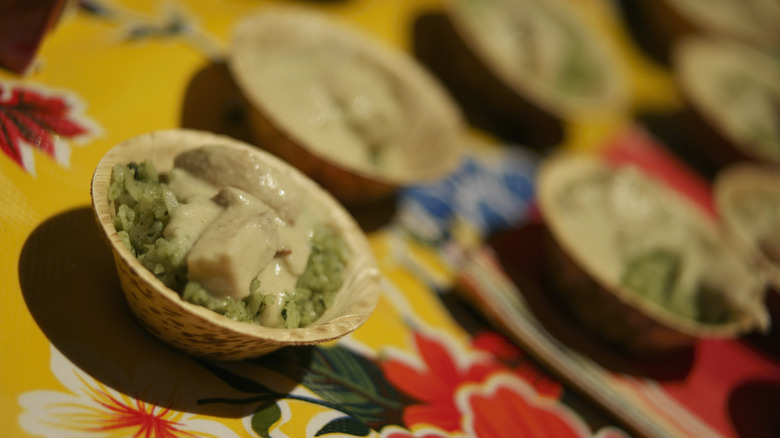What Makes Oaxaca's Mole Blanco Unique?
Traditional Mexican cuisine features an abundance of regional specialties. Say the word Oaxaca, and it's likely the thick and aromatic mole sauce — an iconic offering from the Mexican state — that comes to mind. Prepared with seasonal ingredients, it often reflects what's fresh, backed by generations of tradition. In the U.S., darker-colored red and black varieties of mole are most common, but the sauce encompasses a broader medley of colors. So, for a taste of a less popular yet equally delicious version, turn to mole blanco.
Crafted with nuts, chicken broth, garlic, and chiles, mole blanco boasts a thick consistency with a floral taste. It's served alongside poultry, green beans, and other lighter fare, and showcases a style of mole not dominated by chocolate and peppers. Part spicy, with an aromatic backbone and a garlicky finish, it's a labor-intensive version typically prepared for Christmas and Easter celebrations. Let's dive into the details of this rarer type of mole.
How is mole blanco made?
As with other moles, this white variant utilizes an expansive array of components. Mole blanco's thick texture is nut-based — often a combination of Spanish almonds, pumpkin seeds, peanuts, pine nuts, and sesame seeds. For the liquid element, the dish frequently contains chicken broth, and when it comes to additional flavorings, the dish utilizes spices like cinnamon, coriander, peppercorns, and anise, as well as habaneros or fresh jalapeños for some heat. Plus, it's all backed by garlic and compounded with aromatics like bell pepper and onion. For a filler, some recipes include bread or masa. Finally, sweeter notes come through dried fruit and white chocolate.
Preparation techniques differ, however, there is a general order for ingredient combinations. First, the nuts are heated until golden in color, then set aside. Then the peppers are roasted, oftentimes with the onions. Next comes the chicken broth, into which the peppers are blended. This is also designated for later use. Finally, the mole can be constructed. Onions and garlic are sautéed, after which the pepper broth mixture is poured into the pan. The spices, dried fruit, and nuts are stirred in, and the combination is cooked down for 20 to 30 minutes. Once the flavors have melded, the mixture gets blended.
Why is mole blanco considered rare?
Mole blanco is not designated as one of Oaxaca's seven moles, which gives it far less of a spotlight than the other flavored creations from the Mexican state. Rather than being a staple at restaurants or in home-cooked meals, it's instead prepared exclusively during holidays and celebrations. Plus, it's a Mixteca dish, hailing from a region further from the bustling restaurant scene of the city of Oaxaca. With an incredible range of biodiversity, indigenous tradition, and remote areas, the Oaxacan region encompasses numerous takes on mole, yet many of them continue to remain in obscurity.
Until recently, mole blanco has remained virtually unknown outside of Mexico. However, chef Natalia Mendez of La Morada has started serving mole blanco upon request in her Bronx restaurant. This has attracted media attention to the dish, in turn increasing its popularity. As a result, more restaurants and recipes are highlighting the dish, so snag a bite when available.
How does mole blanco compare to other varieties?
As Oaxaca's most encompassing dish, mole can take on a wide variety of forms. From how the sauce is crafted to what it's served with, nearly every rendition will have a unique trait. All versions do share common attributes, namely a toasted seed base ground in a traditional molcajete (mortar and pestle), although many modern cooks are turning to blenders.
Of the seven famed moles, mole blanco is most similar to the verde variety. It forgoes dried chiles, a common flavor base in most other types. Instead, it utilizes the heat of fresh jalapeño, creating a tangier undertone. Additionally, both of these types have a brighter, more floral flavor due to a shorter cooking time. Darker-tinged varieties may take several hours to simmer.
Nevertheless, mole blanco offers a character distinct from other types. It has a thicker consistency than most lighter-colored renditions. Plus, its garlic-forward flavor profile is distinct among moles since few use the European-introduced ingredient as a principal component.
How is mole blanco served?
Traditionally, mole blanco is served with an edible flower called pípí, which grows around the Mixtec region. It can be accompanied by poultry, especially turkey, rabbit, and chiles rellenos. And, as is common for Mexican cuisine, a tortilla in some form is a staple side to mole. When plated, the sauce is typically lathered atop boiled chicken, which is often prepared during the creation of the broth. A sprinkling of sesame seeds goes on top, along with an herb or flower petal garnish.
Mole's malleable nature is forgiving, so feel free to serve it with something more fitting to your own preferences. With its more delicate flavor, mole blanco complements fish and other seafood. Since it's served with green bean-like vegetables in Oaxaca, consider pairing the dish with other roasted greens, like broccoli. No matter what's used alongside the sauce, the mole will be the star — its flavor is distinctly delectable.




